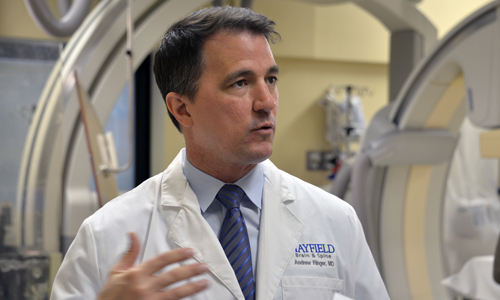
By Andrew Ringer, MD
The passing of actor Luke Perry from a massive stroke at age 52 reminds us that a stroke can happen to anyone at any age. It also reminds us that we need to know the signs and symptoms of a stroke, because if a stroke happens, treatment should begin as soon as possible.
Older adults are more at risk of stroke than younger adults like Mr. Perry, the star of “Beverly Hills 90210.” But strokes do occur across the age spectrum. In rare instances, even children have suffered strokes.
Our age and family history are risk factors for stroke that we cannot control; we can’t stop aging and we can’t choose our parents. But there are several risk factors that we can control, including tobacco use, having high blood pressure, having unhealthy eating habits, and having diabetes. No matter our age, we can reduce our risk of stroke by adopting healthy behaviors and by following treatment recommendations of our physicians.
There are two types of stroke: 1) an ischemic stroke, which occurs when a clot blocks blood flow to the brain; and 2) a bleeding stroke, caused by a hemorrhage, a ruptured aneurysm (a balloon-like bulge on a blood vessel), or an arterial dissection (a tear in the lining of an artery). As of today, we do not know which type of stroke Mr. Perry suffered or what might have caused it. News reports indicate that he was alert when paramedics arrived but that his condition deteriorated.
Medical providers often say that, following a stroke, “time is brain.” Oxygen-deprived brain cells are dying, and the sooner treatment is provided the better the patient’s outcome is likely to be. For an ischemic stroke, this means dissolving the clot with tPA and/or extracting it in a procedure called a thrombectomy. After a bleeding stroke, we must stop the bleeding.
You can remember the signs and symptoms of stroke with the mnemonic F-A-S-T.
• F for drooping of the face, especially on one side
• A for drooping of the arm, especially on one side
• S for slurred speech or the inability to talk
• T for time to call 9-1-1.
A severe, sudden headache that is not like any other headache you’ve had could also be a sign of stroke.
We have made important strides in our treatment of stroke. It wasn’t that long ago that we thought that after 3 hours we couldn’t do anything for our patients. That treatment window expanded to 4.5 hours, then 6 hours. Research published last year widened the window even further, to 24 hours for patients with large-vessel blockages who are candidates for thrombectomy.
But even if the emergency thrombectomy cannot help, there is still a chance for surgeons to save your life and improve your outcome. Surgeons at Mayfield are experts in stroke and can identify patients who will need surgery to avoid the life threatening effects of brain swelling before it’s too late. We have helped thousands of people reduce their risk with surgical and minimally invasive procedures.
If you think you’re at risk of having a stroke, please contact us. We can help.
********
Andrew Ringer, MD, is a neurovascular specialist with Mayfield Brain & Spine. He is Chairman of Mayfield and Chief of Neurosciences for the TriHealth Neuroscience Institute.